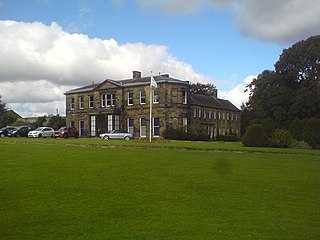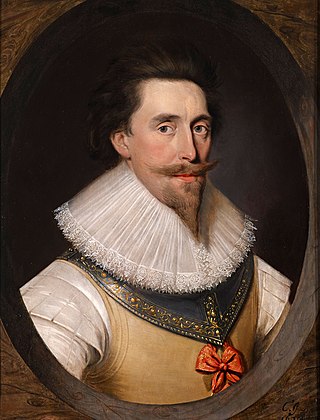
Lismore Castle is a castle located in the town of Lismore, County Waterford in the Republic of Ireland. It belonged to the Earls of Desmond, and subsequently to the Cavendish family from 1753. It is currently the Irish home of the Duke of Devonshire. It was largely re-built in the Gothic style during the mid-nineteenth century for The 6th Duke of Devonshire.

Farnley Hall is a stately home in Farnley, west Leeds, West Yorkshire, England. It is a grade II listed building. It was built in Elizabethan times by the Danbys. The manor is recorded in the 1086 Domesday Book as Fernelei, so it is probable that this house was a replacement for earlier medieval structures.

Earl of Westmorland is a title that has been created twice in the Peerage of England. The title was first created in 1397 for Ralph Neville. It was forfeited in 1571 by Charles Neville, 6th Earl of Westmorland, for leading the Rising of the North. It was revived in 1624 in favour of Sir Francis Fane, whose mother, Mary Neville, was a descendant of a younger son of the first Earl. The first Earl of the first creation had already become Baron Neville de Raby, and that was a subsidiary title for his successors. The current Earl holds the subsidiary title Baron Burghersh (1624).

Earl of Abingdon is a title in the Peerage of England. It was created on 30 November 1682 for James Bertie, 5th Baron Norreys of Rycote. He was the eldest son of Montagu Bertie, 2nd Earl of Lindsey by his second marriage to Bridget, 4th Baroness Norreys de Rycote, and the younger half-brother of Robert Bertie, 3rd Earl of Lindsey. His mother's family descended from Sir Henry Norris, who represented Berkshire and Oxfordshire in the House of Commons and served as Ambassador to France. In 1572 he was summoned by writ to Parliament as Lord Norreys de Rycote. He was succeeded by his grandson, the second Baron. In 1621, he created Viscount Thame and Earl of Berkshire in the Peerage of England. He had no sons and on his death in 1624 the viscountcy and earldom became extinct. He was succeeded in the barony by his daughter Elizabeth, the third holder of the title. On her death, the title passed to her daughter, the aforementioned Bridget, the fourth Baroness, and second wife of the second Earl of Lindsey.

Marquess of Abergavenny in the County of Monmouth, is a title in the Peerage of the United Kingdom created on 14 January 1876, along with the title Earl of Lewes, in the County of Sussex, for the 5th Earl of Abergavenny, a member of the Nevill family.

Earl of Ducie is a title in the Peerage of the United Kingdom. It was created in 1837 for Thomas Reynolds Moreton, 4th Baron Ducie.

Earl of Strafford is a title that has been created three times in English and British history.

Baron Leigh has been created twice as a hereditary title, once in the Peerage of England and once in the Peerage of the United Kingdom. The first creation came in the Peerage of England 1643 when Sir Thomas Leigh, 2nd Baronet, was created Baron Leigh, of Stoneleigh in the County of Warwick. The Leigh Baronetcy, of Stoneleigh in the County of Warwick, had been created in 1611 for his grandfather and namesake Thomas Leigh. The latter was the second son of Sir Thomas Leigh, Lord Mayor of London in 1558, whose third son Sir William Leigh was the grandfather of Francis Leigh, 1st Earl of Chichester. The titles became extinct on the death of the fifth Baron Leigh in 1786.

Sir William Brooke, 10th Baron Cobham, KG, lord of the Manor of Cobham, Kent, was Lord Warden of the Cinque Ports, and a member of parliament for Hythe. Although he was viewed by some as a religious radical during the Somerset Protectorate, he entertained Queen Elizabeth I of England at Cobham Hall in 1559, signalling his acceptance of the moderate regime.

George Nevill, 5th Baron Bergavenny KG, PC, the family name often written Neville, was an English nobleman and courtier who held the office of Lord Warden of the Cinque Ports.
Lord Rupert Charles Montecute Nevill was Chairman of the British Olympic Association from 1966 to 1977 and then its President until his death. As a courtier, he was treasurer and later private secretary to Prince Philip, Duke of Edinburgh, between 1970 and 1982.
The title Baron Latimer or Latymer has been created, by the definitions of modern peerage law, four times in the Peerage of England. Of these, one was restored from abeyance in 1913; one is forfeit; the other two are dormant, although their heir is well known.
Henry Nevill, de facto 9th Baron Bergavenny was an English iron founder, soldier and politician who sat in the House of Commons at various times between 1601 and 1622 when he inherited the Baron Bergavenny peerage.

Francis Fane, 1st Earl of Westmorland, of Mereworth in Kent and of Apethorpe in Northamptonshire was an English landowner and politician who sat in the House of Commons between 1601 and 1624 and then was raised to the Peerage as Earl of Westmorland.

Grantley Hall is a Country house located in North Yorkshire, England. It is situated near Grantley, about 5 miles (8 km) to the west of Ripon, on the banks of the River Skell. It is listed Grade II* on the National Heritage List for England, and the Japanese garden at the hall is listed Grade II on the Register of Historic Parks and Gardens.
Hon. Sir Edward Herbert was an English politician and landowner. His aunt, Katherine Parr, was the sixth, and final, wife of King Henry VIII.

Stoke Place is a country house in Stoke Poges in Buckinghamshire.
Francis Barchard (1796–1856) was an English dyer who became a landowner in Sussex and served as High Sheriff of Sussex.

Maison Talbooth, Dedham in Essex is a building of historical significance. The construction was started in 1846 and completed by 1850. The architect was John Brown from Norwich who has been described as the most successful Norwich architect of the early 19th century. It was the home of many notable residents over the next century and in 1969 was converted into a hotel. It still serves this function today providing accommodation and restaurant facilities.

Gillingham Hall is a Jacobean manor house in the village of Gillingham, Norfolk, England. It is a Grade II* Listed Building.
















